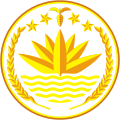
A | B | C | D | E | F | G | H | CH | I | J | K | L | M | N | O | P | Q | R | S | T | U | V | W | X | Y | Z | 0 | 1 | 2 | 3 | 4 | 5 | 6 | 7 | 8 | 9
| The caretaker government of Bangladesh | |
|---|---|
| বাংলাদেশের তত্ত্বাবধায়ক সরকার | |
 Seal of the Chief Advisor | |
 Standard of the Chief Adviser | |
| Style | His Excellency (Diplomatic) Honourable Chief Advisor (Informal) Honourable (Official) |
| Status | Active |
| Member of | |
| Residence | |
| Appointer | Statutory: President of Bangladesh |
| Term length | 3 months or higher |
| Formation | 26 March 1996 |
| First holder | Shahabuddin Ahmed (1991) |
| This article is part of a series on the |
| Politics of Bangladesh |
|---|
 |
|
|
|
|
A caretaker government of Bangladesh, (Bengali: বাংলাদেশের তত্ত্বাবধায়ক সরকার) is an unelected interim government in Bangladesh tasked with organizing free and fair general elections. The Chief Adviser, the head of government in lieu of the Prime Minister, is appointed by the President. The Chief Advisor appoints other advisers, who act as ministers. The appointments are intended to be nonpartisan.
The caretaker government is only permitted to make necessary policy decisions, and may not contest the elections.
History
1996 constitutional amendment
In late-1990, violent pro-democracy unrest led General Hussain Muhammad Ershad to resign as president. A coalition of political parties appointed Chief Justice Shahabuddin Ahmed as acting president to lead a interim government. The transitional government was replaced after the 1991 general election.
In 1996, the 13th amendment to the Constitution of Bangladesh formalized the practice of nonpartisan interim ("caretaker") governments.
2006-2008 caretaker government

In late-2006, President Iajuddin Ahmed formed a caretaker government. Chief Justice K.M. Hasan was unable to fill the role of Chief Advisor; according to the Awami League, the outgoing government — controlled by Prime Minister Khaleda Zia's Bangladesh Nationalist Party (BNP) — appointed Hasan as Chief Justice to influence the caretaker government. The dispute resulted in violent unrest and the cancellation of the January 2007 general election.
Fakhruddin Ahmed formed a new caretaker government in January 2007 supported by the Bangladesh Armed Forces. The caretaker government maintained a limited state of emergency while pursuing Awami and BNP members for corruption. The caretaker government was replaced after the 2008 general election, having exceeded the constitutionally-mandated term limit of 120-days.
Abolition
In 2011, the Prime Minister Sheikh Hasina's Awami League-led government abolished caretaker governments with the 15th constitutional amendment.[1] This amendment was opposed by the BNP and other parties.[2] According to Hasina, the courts could dissolve parliament.[3] According to Ershad in 2012, there was popular support for caretaker governments.[4]
Reinstatement
In 2024, after the resignation of Sheikh Hasina as the prime minister of Bangladesh, the coordinators of the Anti-discrimination Students Movement (Bengali: বৈষম্যবিরোধী ছাত্র আন্দোলন) announced an interim government. This includes two members of the Anti-discrimination Students Movement and Dr. Muhammad Yunus as the chief advisor to the government.[5][6][7]
Process
The scope of caretaker government was defined in the 13th constitutional amendment. There were six options for the appointment of Chief Advisor, with the President being the last. The caretaker government had to hold elections within 90 days, and hand over power to the newly-elected government within 120 days. It was responsible for maintaining day-to-day government operations, routine duties, and organizing general elections.
References
- ^ Liton, Shakhawat; Hasan, Rashidul (1 July 2011). "Caretaker system abolished". The Daily Star.
- ^ "Running Elections in Bangladesh", The Economist, August 2012
- ^ সংসদ রেখে নির্বাচন হবে না [The Parliamentary Election Will Not Be]. Prothom Alo (in Bengali). 19 September 2012. Archived from the original on 22 September 2012.
- ^ 'টাইমস অব ইন্ডিয়া'কে এরশাদ, পাঁচ বছর অন্তর জনগণ সরকারের পরিবর্তন চায় ['Times of India' Who says, wants to change the government's five-year intervals]. Daily Manab Zamin (in Bengali). 23 August 2012. Archived from the original on 2 November 2012.
- ^ "Meet the 2 students who are now advisers to Bangladesh's interim govt". The Business Standard. 8 August 2024. Retrieved 8 August 2024.
- ^ Correspondent, Staff (7 August 2024). "Another day passes without govt". The Daily Star. Retrieved 8 August 2024.
- ^ "Bangladesh protesters expect interim government to be finalized on Wednesday". CNBC.
External links
- "List of advisers and portfolios". Bangladesh Government. Archived from the original on 11 June 2007.
- Hasanuzzaman, Al Masud (2012). "Caretaker Government". In Islam, Sirajul; Jamal, Ahmed A. (eds.). Banglapedia: National Encyclopedia of Bangladesh (Second ed.). Asiatic Society of Bangladesh.
- "Khairul Haque made CJ". New Age. Dhaka. 27 September 2010. Archived from the original on 1 October 2010.
Text je dostupný za podmienok Creative Commons Attribution/Share-Alike License 3.0 Unported; prípadne za ďalších podmienok. Podrobnejšie informácie nájdete na stránke Podmienky použitia.
Antropológia
Aplikované vedy
Bibliometria
Dejiny vedy
Encyklopédie
Filozofia vedy
Forenzné vedy
Humanitné vedy
Knižničná veda
Kryogenika
Kryptológia
Kulturológia
Literárna veda
Medzidisciplinárne oblasti
Metódy kvantitatívnej analýzy
Metavedy
Metodika
Text je dostupný za podmienok Creative
Commons Attribution/Share-Alike License 3.0 Unported; prípadne za ďalších
podmienok.
Podrobnejšie informácie nájdete na stránke Podmienky
použitia.
www.astronomia.sk | www.biologia.sk | www.botanika.sk | www.dejiny.sk | www.economy.sk | www.elektrotechnika.sk | www.estetika.sk | www.farmakologia.sk | www.filozofia.sk | Fyzika | www.futurologia.sk | www.genetika.sk | www.chemia.sk | www.lingvistika.sk | www.politologia.sk | www.psychologia.sk | www.sexuologia.sk | www.sociologia.sk | www.veda.sk I www.zoologia.sk



